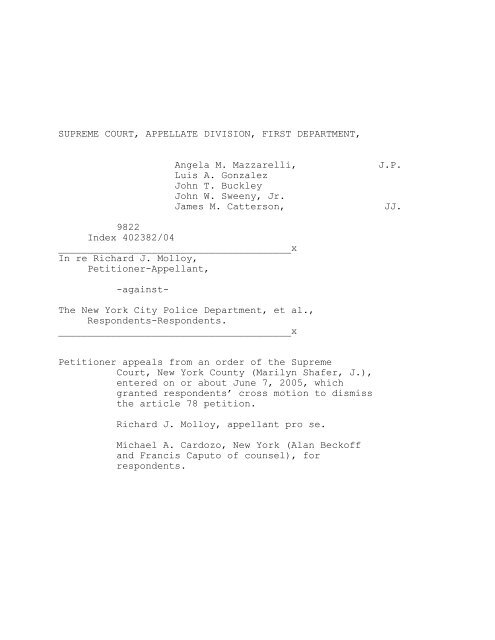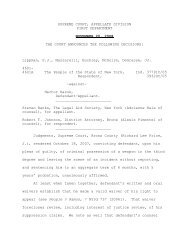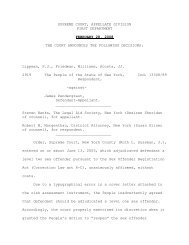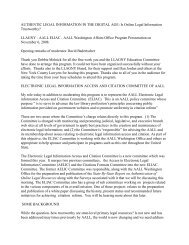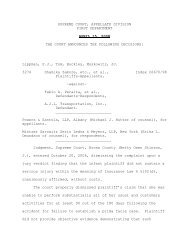SUPREME COURT, APPELLATE DIVISION, FIRST DEPARTMENT ...
SUPREME COURT, APPELLATE DIVISION, FIRST DEPARTMENT ...
SUPREME COURT, APPELLATE DIVISION, FIRST DEPARTMENT ...
You also want an ePaper? Increase the reach of your titles
YUMPU automatically turns print PDFs into web optimized ePapers that Google loves.
<strong>SUPREME</strong> <strong>COURT</strong>, <strong>APPELLATE</strong> <strong>DIVISION</strong>, <strong>FIRST</strong> <strong>DEPARTMENT</strong>,Angela M. Mazzarelli,J.P.Luis A. GonzalezJohn T. BuckleyJohn W. Sweeny, Jr.James M. Catterson, JJ.9822Index 402382/04________________________________________xIn re Richard J. Molloy,Petitioner-Appellant,-against-The New York City Police Department, et al.,Respondents-Respondents.________________________________________xPetitioner appeals from an order of the SupremeCourt, New York County (Marilyn Shafer, J.),entered on or about June 7, 2005, whichgranted respondents’ cross motion to dismissthe article 78 petition.Richard J. Molloy, appellant pro se.Michael A. Cardozo, New York (Alan Beckoffand Francis Caputo of counsel), forrespondents.
BUCKLEY, J.Petitioner was convicted in 1999 of manslaughter in thesecond degree and sentenced to a prison term of 4 to 12 years,for the shooting death of Patrick Phelan (see People v Malloy,282 AD2d 311 [2001], lv denied 96 NY2d 922 [2001]). The defensetheory at trial was that Phelan, an intoxicated, diminutive housepainter, furtively removed the service revolver from the holsterof the much larger petitioner, then an off-duty police officer,and committed suicide (see People v Malloy, 235 AD2d 48 [1997]).Following his conviction, petitioner made a request pursuantto the Freedom of Information Law (FOIL) for documents relatingto specified investigations by the New York City PoliceDepartment (NYPD) Internal Affairs Bureau (IAB) which purportedlywould show a previous attempt by Phelan to take a pistol fromanother officer, as well as prior suicide attempts while inprison in Northern Ireland for activities pertaining to the IRA.The NYPD denied the request on the grounds that “the informationwould reveal non-routine investigative techniques” and “wouldidentify a confidential source/confidential information.”Petitioner filed an administrative appeal, arguing that therequested documents were generated by routine investigativemethods and did not implicate any confidential sources orinformation. The NYPD failed to respond to the administrative2
appeal within 10 days, although required to do so by PublicOfficers Law § 89(4)(a), and petitioner commenced this article 78proceeding. Thereafter, the NYPD issued a response to theadministrative appeal, claiming, inter alia, that disclosure ofthe sought information was barred by Civil Rights Law § 50-a(1),pursuant to which personnel records of a police officer “used toevaluate performance toward continued employment or promotion”are “considered confidential and not subject to inspection orreview without the express written consent of such policeofficer...except as may be mandated by lawful court order.” TheNYPD then cross-moved to dismiss the article 78 petition on thatbasis, which the court granted.In relying on the NYPD’s submissions tendered after theexpiration of the 10-day administrative appeal response period,and after the commencement of the article 78 proceeding, SupremeCourt improperly considered evidence outside the administrativerecord (see HLV Assoc. v Aponte, 223 AD2d 362 [1996]). Theappropriate remedy under the circumstances is to remand to thePolice Department (see Matter of Rhino Assets, LLC v New YorkCity Dept. for the Aging, SCRIE Programs, 31 AD3d 292 [2006]),rather than to direct respondents to produce the requestedmaterials.The documents petitioner seeks, IAB records pertaining to an3
investigation into the actions of a Police Department detective,would appear to implicate, on their face, personnel records ofpolice officers within the meaning of Civil Rights Law § 50-a(1).As noted supra, under that statute, personnel records of a policeofficer “used to evaluate performance toward continued employmentor promotion” are “considered confidential and not subject toinspection or review without the express written consent of suchpolice officer...except as may be mandated by lawful courtorder.” Thus, “Civil Rights Law § 50-a unambiguously defines therecords that are immune from indiscriminate disclosure” (Matterof Daily Gazette Co. v City of Schenectady, 93 NY2d 145, 154[1999] [emphasis added]). The confidentiality of the statute isdesigned to protect the police officer, not the Department (id.at 154-155), and therefore should not be deemed automaticallywaived by the inaction of the Department.Moreover, where the breadth or good faith of the invocationof the statute is called into doubt, the court should make an incamera inspection of the requested documents (see Matter of Cityof Newark v Law Dept. of the City of N.Y., 305 AD2d 28, 34[2003]). Indeed, the relief sought in the petition specificallyincludes a request for an in camera inspection. Therefore,remanding will not merely permit the NYPD to “craft its responsesin an attempt to fit within the exceptions [to FOIL disclosure],”4
since the court can undertake an in camera inspection of thedocuments if the agency should deny the FOIL request, in whole orin part.Accordingly, the order of the Supreme Court, New York County(Marilyn Shafer, J.), entered on or about June 7, 2005, whichgranted respondents’ cross motion to dismiss the article 78petition, should be reversed, on the law, without costs, thecross motion denied, and the matter remanded to the NYPD forfurther administrative proceedings consistent herewith.All concur except Catterson, J. who concursin part and dissents in part in a separateOpinion.5
CATTERSON, J. (concurring in part, dissenting in part)Because I believe that we should avoid the mischiefattendant in a remand, I write separately. In my opinion, weshould not only reverse but also order the respondents to producethe documents requested.The petitioner is a former police officer, and currentlyconfined to Woodbourne Correctional Facility. In April 1999, hewas found guilty of manslaughter in the second degree andsentenced to 4 to 12 years for the shooting death of PatrickHeslin Phelan, an off-duty police officer. See People v. Molloy,282 A.D.2d 311, 723 N.Y.S.2d 363 (1st Dept., 2001), lv. denied,96 N.Y.2d 922, 758 N.E.2d 665, 732 N.Y.S.2d 639, (2001). Attrial, the petitioner’s sole defense was that Phelan hadsurreptitiously removed the petitioner’s service revolver andfatally shot himself. Following his conviction, the petitionerrequested documents pursuant to the Freedom of Information Law(hereinafter referred to as “FOIL”) regarding an investigationconducted by the NYPD Internal Affairs Bureau (hereinafterreferred to as “IAB”). The petitioner alleges that six monthsprior to trial, Phelan had attempted to surreptitiously remove aservice revolver from another officer, Detective Byrnes, and thatstatements about this incident had been made to his superiors andto IAB. The petitioner also alleges that IAB conducted an6
investigation into prior suicide attempts made by Phelan while inprison in Northern Ireland for various IRA activities.By a letter dated March 15, 2004 to the NYPD FOIL unit, thepetitioner requested all records pertaining to the IABinvestigation of Phelan with respect to his suicide attempts.Respondent NYPD denied the request by a letter dated March 31,2004, on the grounds that release of the information would“reveal non-routine investigative techniques” and “identify aconfidential source/confidential information.”The petitioner timely filed an administrative appeal onApril 18, 2004 challenging the respondents’ determination asarbitrary, capricious, and irrational. He further claimed thedocuments would not reveal non-routine investigative techniquesor confidential sources or information. Specifically, thepetitioner argued that the documents requested had been generatedby question and answer interviews which is considered a routineinvestigative method. The petitioner also argued that at no timedid any of the officers serve as confidential informants orpossess confidential information under Public Officers Law §87(2).The petitioner received no response from the NYPD regardinghis administrative appeal. Under Public Officers Law § 89(4)(a),the agency must "within ten business days of the receipt of such7
appeal fully explain in writing to the person requesting therecord the reasons for further denial, or provide access to therecord sought." The petitioner construed the failure to respondto be a constructive denial of his appeal and, that, therefore hehad exhausted all his administrative remedies as required. OnJuly 7, 2004, he filed an article 78 petition.On August 4, 2004, more than two months after thepetitioner’s filing of the administrative appeal, and 28 daysafter filing the article 78 petition, NYPD Records Access AppealsOfficer, Jonathan David, responded to the administrative appeal.The NYPD affirmed the denial of the petitioner’s request,asserting (1) that access to the records was barred by statute(Civil Rights Law § 50-a); (2) that the records were “non-finalintra-agency materials exempt pursuant to Public Officers Law §87(2)(g)”; and (3) that the records would identify confidentialinformation or disclose confidential information relating to acriminal investigation pursuant to Public Officers Law §87(2)(e)(iii). In response to the petitioner’s article 78proceeding, the respondents cross-moved to dismiss the petitionunder CPLR 3211(a)(2) and (7) on the grounds that the courtlacked subject matter jurisdiction and the petition failed tostate a cause of action because the records sought were exempt8
pursuant to Civil Rights Law § 50-a(1) and Public Officers Law §87(2)(a).Public Officers Law § 87(2)(a) provides that “[e]ach agencyshall [. . .] make available for public inspection and copyingall records, except that such agency may deny access to recordsor portions thereof that are specifically exempted fromdisclosure by state or federal statute.” Civil Rights Law § 50-a(1) provides that all personnel records “used to evaluateperformance toward continued employment or promotion, under thecontrol of any police agency or department of the state [. . .]shall be considered confidential and not subject to inspection orreview without the express written consent of such police officer[. . .] except as may be mandated by lawful court order.”By a written decision dated June 7, 2005, Supreme Courtanalyzed the denial under Civil Rights Law § 50-a, and held thatthere was “substantial evidence to support a rational basis forRespondents’ denial of [the] FOIL request.” In effect, the courtfound that the records were “‘used to evaluate performance towardcontinued employment’ within the ambit of Civil Rights Law § 50-a(1).”The petitioner appeals that judgment on the grounds that thecourt below erred in denying his article 78 petition byconsidering evidence outside the administrative record. For the9
easons set forth below, I concur with the majority in holdingthat the court erred in considering evidence outside of therecord but I must respectfully dissent as to the remedy.The precedent established by this Court requires that on anarticle 78 proceeding the reviewing court is limited toconsideration of evidence and arguments raised before the agency1when the administrative determination was rendered. See Matterof HLV Assoc. v. Aponte, 223 A.D.2d 362, 363, 636 N.Y.S.2d 52(1st Dept., 1996). Indeed, “[t]his Court has repeatedly rejectedparties’ attempts to raise issues on appeal for the first timewhere they neglected to raise those issues at an administrativehearing.” Matter of Torres v. New York City Hous. Auth., 40A.D.3d 328, 330, 835 N.Y.S.2d 184, 186 (1st Dept., 2007), citingDistrict Council 37, Am. Fedn. of State, County & Mun. Employees,AFL-CIO v. City of New York, 22 A.D.3d 279, 804 N.Y.S.2d 10 (1stDept., 2005) and Matter of Wallace v. Envtl. Control Bd., 8A.D.3d 78, 778 N.Y.S.2d 477 (2004); see also Matter of Lewis v.Village Bd. of Trustees, 48 A.D.2d 952, 368 N.Y.S.2d 883 (3dDept., 1975) (holding that an issue not raised in the prior1Interestingly, the lower court recognized this principle but then failed toapply it (holding that “[a]n [a]rticle 78 proceeding is limited toconsideration of the evidence and arguments raised before the agency when theadministrative determination was rendered and ‘[t]he function of the court . .. is to determine . . . whether the determination had a rational basis in therecord’” [quoting Matter of HLV Assoc. v Aponte, 223 A.D.2d 362, 363, 636N.Y.S.2d 52 (1st Dept., 1996) (citations omitted)]).10
hearing is not properly before the court). Indisputably, “[f]ora court to consider evidentiary submissions as to thecircumstances after the [NYPD] made its determination wouldviolate [a] fundamental tenet of CPLR article 78 review, namelythat judicial review of administrative determinations is confinedto the facts and record adduced before the agency.” Matter ofTorres v. New York City Hous. Auth., 40 A.D.3d at 330, quotingMatter of Featherstone v. Franco, 95 N.Y.2d 550, 554, 742 N.E.2d607, 610, 720 N.Y.S.2d 93, 96 (2000).In this case, the administrative record was limited to theevidence submitted before the petitioner commenced the instantaction. The subsequent denial of the administrative appeal wasbased on new and different reasons and was submitted after thepetitioner had correctly construed silence as constructive denialand had filed the article 78 petition. Thus, these were notissues raised previously at the administrative level, and so, inmy opinion, were improperly submitted into evidence andconsidered by the court below when it granted the respondents’cross motion to dismiss the petition under CPLR 3211(a)(2) and(7).The respondents failed to take “the opportunity [afforded tothem], in advance of possible judicial review, to prepare a11
ecord reflective of its expertise and judgment.” Watergate IIApts. v. Buffalo Sewer Auth., 46 N.Y.2d 52, 57, 412 N.Y.S.2d 821,827, 385 N.E.2d 560, 563 (1978) (citing and internal quotationmarks omitted). In this case, it appears that once the article78 proceeding had been commenced, the respondents crafted theiranswers to the rationale of the denial of the administrativeappeal, thus circumventing the petitioner’s Article 78 petition.As a result, as the petitioner aptly states in his brief, “at therisk of mixing metaphors, [the respondents] were able to get asecond bite of the apple after initially dropping the ball.”The purpose of FOIL is “[t]o promote open government andpublic accountability” and it “imposes a broad duty on governmentto make its records available to the public.” Matter of Gould v.New York City Police Dept., 89 N.Y.2d 267, 274, 653 N.Y.S.2d 54,57, 675 N.E.2d 808, 811 (1996). All documents are presumptivelyavailable for review unless they fall under one of the exceptionspursuant to Public Officers Law § 87(2). See Matter of M.Farbman & Sons, Inc. v. New York City Health & Hosps. Corp., 62N.Y.2d 75, 476 N.Y.S.2d 69, 464 N.E.2d 437 (1984). The“exemptions [to FOIL] are to be narrowly construed, with theburden resting on the agency to demonstrate that the requested12
material indeed qualifies for exemption.” Matter of Hanig v.State of New York Dept. of Motor Vehicles, 79 N.Y.2d 106, 109,580 N.Y.S.2d 715, 717, 588 N.E.2d 750, 752 (1992). Itnecessarily follows that by allowing the NYPD to construct itspreviously unarticulated rationale to fit into an exception inthe post-administrative phase, the majority circumvents theentire purpose of FOIL. Remanding the matter would undoubtedlyproduce the same result as it will allow the agency to now craftits responses in an attempt to fit within the exceptions.Moreover, I contend that our determination in Matter ofRhino Assets, LLC v. New York City Dept. for the Aging, SCRIEPrograms (31 A.D.3d 292, 819 N.Y.S.2d 247 (1st Dept. 2006)) doesnot constrain us to remand. In that case, the petitioners in amandamus proceeding sought to compel the respondents to reply totheir repeated requests for documents pursuant to FOIL. Therespondents finally replied to the request in a cross motion fordismissal of the article 78 proceeding. The court ruled againstthe production of the documents on the basis of that reason.Since, no reason whatsoever was given at the administrativelevel, there was no record before the court, and so its rulingwas improper. However, the petitioners, on appeal, pursued onlymandamus relief. Thus, our determination ordering the13
espondents to provide a reply and remanding the matter for ahearing on the substantive merits of the reply provided preciselythat relief sought by the petitioners on appeal.THIS CONSTITUTES THE DECISION AND ORDEROF THE <strong>SUPREME</strong> <strong>COURT</strong>, <strong>APPELLATE</strong> <strong>DIVISION</strong>, <strong>FIRST</strong> <strong>DEPARTMENT</strong>.ENTERED: FEBRUARY 7, 2008_______________________CLERK14


